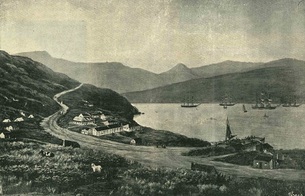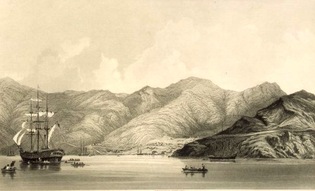The Bridle Path (and other adventures)
Originally it was intended to build a road to Christchurch over Evans Pass but when it became apparent that because of lack funds there would be no time to complete the route before the settlers arrived, John Robert Godley, the Chief Agent for the Canterbury Association, ordered Chief Surveyor, Captain Thomas, to stop work on the road and effort was diverted to a temporary Bridle Path directly over the hill from Lyttelton. Until this was completed in January 1851, settlers had to go by boat around to Sumner and then on to Ferrymead, where ferries could take them and their belongings further along what came to be known as the Avon River. To do this they had to cross the treacherous Sumner Bar, which caused many shipwrecks, so it was not surprising that settlers chose to climb the steep Bridle Path rather than go by sea. However, heavy belongings continued to be transported by sea until the Lyttelton-Sumner Road was completed in 1857.
Communication problems
Dispatches by sea would take over three months to reach England and a similar time to get a response. The dispatch below from Godley about the road to Christchurch gives a good sense of some of the frustrations he and the others who came to prepare the settlement faced.
January 6th 1851
SIR,-
…I informed the Association in my first dispatch, that I wished very much to have time and funds to finish the road before the arrival of the colonists. That dispatch did not arrive in England until too late for giving effect to the advice contained in it, and the result has been, as I foresaw, that we are involved in no small difficulty… the bridle-path will be finished next week; at present, indeed, it could be but very little used if it were finished, as there are hardly any horses in the settlement belonging to the Association.
Source: Canterbury Papers No. 5 and 6, Canterbury Association, 1850..
Christchurch City Libraries
Pages: 1 2 3
__________________________________________________________________________
Haere Mai, Welcome / Solving History’s Mysteries / Will you join us? / Our Journey / Our New Land / Resources / About this site / Links / Sitemap
Communication problems
- Imagine the difficulties of establishing a new settlement without the almost instant communications available to us today.
Dispatches by sea would take over three months to reach England and a similar time to get a response. The dispatch below from Godley about the road to Christchurch gives a good sense of some of the frustrations he and the others who came to prepare the settlement faced.
January 6th 1851
SIR,-
…I informed the Association in my first dispatch, that I wished very much to have time and funds to finish the road before the arrival of the colonists. That dispatch did not arrive in England until too late for giving effect to the advice contained in it, and the result has been, as I foresaw, that we are involved in no small difficulty… the bridle-path will be finished next week; at present, indeed, it could be but very little used if it were finished, as there are hardly any horses in the settlement belonging to the Association.
Source: Canterbury Papers No. 5 and 6, Canterbury Association, 1850..
Christchurch City Libraries
Pages: 1 2 3
__________________________________________________________________________
Haere Mai, Welcome / Solving History’s Mysteries / Will you join us? / Our Journey / Our New Land / Resources / About this site / Links / Sitemap


